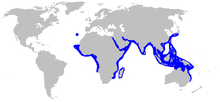
Back Melkhaai Afrikaans القرش الحليب ARZ Млечна акула Bulgarian চোখা হাঙ্গর Bengali/Bangla Tauró de musell punxegut Catalan Rhizoprionodon acutus CEB Milchhai German Blekponamu EE Laktoŝarko Esperanto Rhizoprionodon acutus Spanish
| Milk shark | |
|---|---|

| |
| Scientific classification | |
| Domain: | Eukaryota |
| Kingdom: | Animalia |
| Phylum: | Chordata |
| Class: | Chondrichthyes |
| Subclass: | Elasmobranchii |
| Subdivision: | Selachimorpha |
| Order: | Carcharhiniformes |
| Family: | Carcharhinidae |
| Genus: | Rhizoprionodon |
| Species: | R. acutus
|
| Binomial name | |
| Rhizoprionodon acutus (Rüppell, 1837)
| |

| |
| Range of the milk shark | |
| Synonyms | |
|
Carcharias aaronis Hemprich & Ehrenberg, 1899 | |
The milk shark (Rhizoprionodon acutus) is a species of requiem shark, and part of the family Carcharhinidae, whose common name comes from an Indian belief that consumption of its meat promotes lactation. The largest and most widely distributed member of its genus, the milk shark typically measures 1.1 m (3.6 ft) long, and can be found in coastal tropical waters throughout the eastern Atlantic and the Indo-Pacific regions. Occurring from the surface to a depth of 200 m (660 ft), this species is common near beaches and in estuaries, and has been recorded swimming up rivers in Cambodia. Juveniles are known to inhabit tidal pools and seagrass meadows. The milk shark has a slender body with a long, pointed snout and large eyes, and is a nondescript gray above and white below. This shark can be distinguished from similar species in its range by the long furrows at the corners of its mouth, and seven to 15 enlarged pores just above them.
Among the most abundant sharks within its range, the milk shark feeds primarily on small bony fishes, but also takes cephalopods and crustaceans. In turn, it often falls prey to larger sharks and possibly marine mammals. In common with other members of its family, this species is viviparous, with the developing embryos sustained by a placental connection. Females give birth to one to eight young either during a defined breeding season or throughout the year, depending on location. The reproductive cycle is usually annual, but may be biennial or triennial. Large numbers of milk sharks are caught by artisanal and commercial fisheries in many countries for meat, fins, and fishmeal. The International Union for Conservation of Nature has assessed this species as being vulnerable.
- ^ Rigby, C.L.; Harry, A.V.; Pacoureau, N.; Herman, K.; Hannan, L.; Derrick, D. (2020). "Rhizoprionodon acutus". IUCN Red List of Threatened Species. 2020: e.T41850A68642326. doi:10.2305/IUCN.UK.2020-3.RLTS.T41850A68642326.en. Retrieved 19 November 2021.
© MMXXIII Rich X Search. We shall prevail. All rights reserved. Rich X Search
